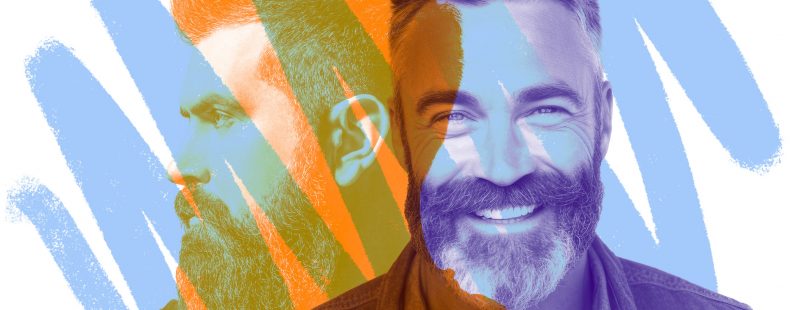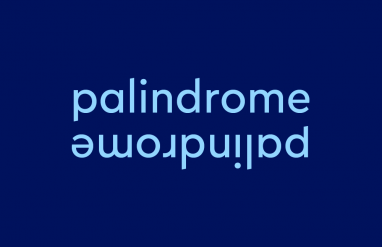Whether you sport a casual mustache or meticulously groom your facial forestry, you likely know that certain types of facial hair have names. Terms like sideburns, goatee, and handlebar mustache are probably familiar to you and may even describe something on your face.
But there are many more types of facial hair than that. To celebrate both words and whiskers, we combed through the bristly tangles of beard and mustache lore. Look no further if you’re a devoted fan of breathtaking beards or in need of a goal to strive for during No-Shave November. This list is just what you’re looking for!
sideburns
Though this retro style is associated with the 1970s, the word sideburns entered English almost 100 years earlier. This eponymic fuzz is named after Civil War general Ambrose Burnside, who sported sideburns—or as they were first called, burnsides—so long they connected to his mustache.
muttonchops
Muttonchops are sideburns that resemble pieces of mutton growing out from under the ears, down to the jaw. Though this style is sure to be spotted in any Pride and Prejudice adaptation, the word didn’t come about until the mid-1800s, more than 30 years after Jane Austen died.
The Van Dyke

The 17th-century Flemish painter Anthony van Dyck is perhaps just as famous for his portraits of the aristocracy as he is for his short, pointed Vandyke beard paired with a thick, upturned mustache. A true trendsetter, he also lent his name to wide lace collars with scalloped edges, often depicted in his paintings. Both the beard and the artist’s name have several spelling variations.
The Fu Manchu
The Fu Manchu, a mustache with ends that droop to the chin or beyond, is named after the character Dr. Fu Manchu, a master criminal from the novels of Sax Rohmer. These novels were made into popular films in the 1920s and ’30s, and the term took off from there.
goatee
Goatees—which even the trickster Pan sported in ancient Greek times—received their moniker in the 1800s. Fittingly, this Americanism refers to the resemblance between this tuft of hair and the tuft that grows from a goat’s chin.
five o’clock shadow
The five o’clock shadow is the stubble that appears on a man’s face, typically in the late afternoon, if he shaved that same morning. A very short beard is also called a five o’clock shadow.
handlebar mustache
The handlebar mustache, often just called a handlebar, is marked by its long curved ends. Its resemblance to a bicycle handlebar gives it its name.
English mustache
The English mustache is a thinner, shorter variant of the handlebar mustache that extends straight outward rather than curling up.
imperial mustache
The imperial mustache is a regal variant of the classic handlebar mustache. Unlike the handlebar mustache, the imperial mustache allows the hair to curl naturally by having the mustache join with cheek hair to curl upward. This grandiose mustache was grown by and said to be named for Kaiser Wilhelm II, the last imperial ruler of Germany and Prussia.
chinstrap beard

The chinstrap beard was part of the signature look of Abraham Lincoln, who famously grew out his facial hair at the request of 11-year-old Grace Bedell. She promised Lincoln she would try to get her four brothers to vote for him if only he would grow a beard. “All the ladies like whiskers,” Grace wrote to Lincoln. The chinstrap beard features full sideburns and a beard but no mustache. (The style pictured above pairs a mustache with a classic chinstrap.)
walrus mustache
The walrus mustache is a thick, shaggy mustache that hangs loosely on the face. Its name comes from the fact that it often resembles the fuzzy hair on the face of a walrus.
horseshoe mustache
This mustache grows down from the upper lips to the chin in two thick vertical lines, thought to resemble a horseshoe. Professional wrestler Hulk Hogan wears this style with a yellow-white ‘stache that seems to almost emit a glow from his lower face.
pencil mustache
The pencil mustache has graced many famous faces from swashbuckling actor Errol Flynn to musician Little Richard to eccentric filmmaker John Waters. This ultra-thin mustache sits neatly above the upper lip and requires impeccable upkeep.
The Verdi

The Verdi beard is a full beard that is trimmed thin on the sideburns and cheeks but left to grow full past the chin. The beard is paired with a full, curly mustache. This style is named for Italian composer Giuseppe Verdi, whose magnificent beard was outdone only by his operas.
toothbrush mustache
The toothbrush mustache, over time, has taken on the names of its most notable wearers, including Charlie Chaplin and Adolf Hitler. It was popularized in the late 1800s in the United States, though its popularity has since sharply declined due to negative associations with Hitler and Nazi Germany.
soul patch
A soul patch is a small patch of hair below the lower lip but above the chin. The soul patch has had many names throughout its history, and it is often traced back to jazz musicians, especially trumpet player Dizzy Gillespie.
chevron mustache
The chevron mustache is a full mustache that covers part of the upper lip and extends past the corners of the lip. Tom Selleck and Freddy Mercury are two examples of men who rocked the chevron ‘stache on many occasions.
painter’s brush mustache
The painter’s brush mustache is a shorter, neatly trimmed version of the chevron mustache. It doesn’t extend past the lip and often has rounded edges. Actor Nick Offerman’s character Ron Swanson often sported this ‘stache on the TV show Parks and Recreation (2009).
Shenandoah beard

The Shenandoah beard, also known as an Amish beard or chin curtain, is a long, thick beard with sideburns that has no mustache or hair above the chin. The name Shenandoah likely refers to the Shenandoah Valley in Virginia, which has been home to a large Mennonite community and people who grow Shenandoah beards.
Hungarian mustache
The Hungarian mustache is a hybrid of the handlebar and walrus mustaches that results in a large, swoopy mustache. Archduke Franz Ferdinand and Wild West lawman Wyatt Earp are two examples of historical figures that sported the awe-inspiring Hungarian mustache.
Dali mustache
The absurd Dali mustache is a very long and thin mustache that points upward. The mustache is named for Spanish painter Salvador Dali, who famously and eccentrically styled his mustache in this way.
neckbeard
A neckbeard is a patch of facial hair that grows across the neck. This facial hair is often attributed to poor grooming and often linked to people with poor social skills. The derogatory term neckbeard is often used to refer to socially awkward men and teenage boys.
The Zappa
The Zappa beard, Zappa mustache, or Zappa goatee features a soul patch paired with a thick mustache that curls downward slightly past the corners of the mouth. This facial hair is named for musician Frank Zappa, who styled his facial hair this way.
The Balbo

The Balbo beard is a work of facial art that involves the whole face. A Balbo beard features a trimmed beard with no sideburns or hair on the cheeks. The beard is accompanied by a soul patch and a trimmed mustache that is usually disconnected from the beard. Actor Robert Downey Jr. has often sported variations of the Balbo. The Balbo beard is named after Italian aviator and politician Italo Balbo, whose look included this facial hair style.
beardstache
The beardstache is, as the name suggests, a style that combines a beard and mustache. There is a lot of leeway with the beardstache, but the main requirement is that the mustache hair is longer than the beard hair. Beyond that, the style is up to the person’s imagination.
lumberjack beard
The iconic lumberjack beard is rugged and intimidating. It features a thick, full beard that covers the chin, cheeks, and neck paired with a thick mustache that merges with the beard. The name of the beard refers to the stereotypical masculine image of the wood-cutting lumberjack, exemplified by the legendary Paul Bunyan.
ducktail beard

The ducktail beard style features a full beard and mustache. The beard has a triangular shape, ending with a point. Many popular depictions of slick, bearded devils offering deals often depict them sporting ducktail beards. As you might have guessed, this beard is named after its supposed resemblance to the tail of a duck.
gunslinger beard
Draw! The most common gunslinger beard style features a horseshoe mustache that connects to full sideburns while the chin is left bare. The name most likely harks back to the masculine image of gunslingers from the Wild West.
The quiz of beard and mustache styles
If you’re not scared of a close shave, we mustache you to try our quiz on facial hair terms.














